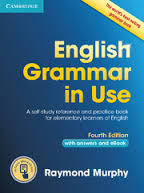English Grammar in Use

4th edition, book with answers
Many teachers and students will be familiar with Raymond Murphy’s grammar books. They are almost a standard – but using them requires care! They are not systematic, and not complete: the aim is to cover the main difficult points of English grammar which need practice.
There are three volumes of these grammar books from Cambridge University Press in common use: red for beginners, blue for intermediate, and green for advanced learners. The style is common, so this review applies in part to all three.
Here I review the blue book, English Grammar in Use, the fourth edition of a book originally published in 1985. It comes in five forms: with or without answers, with or without CD-ROM, and online. The book is identical in structure to the third edition – there are no new units or other material, though a few have been rewritten or replaced.
I have not reviewed the CD-ROM, but from online sources, it seems to be identical to that developed for the third edition. It contains further exercises on all units and a database of 1700 questions. The online version is excellent, and gives an excellent overview of the book. Try it on www.englishgrammarinuseonline.cambridge.org
Murphy’s books have been advertised for self-study, where students should choose whichever topics they feel they need to improve. However, in my opinion, this is very difficult. Without an overview, and without knowing which areas of grammar are more important than others, the average student would become lost in detail. It is an area where the teachers should decide which method is best for the way their students should work and the aims of the course.
The book has 145 units covering 15 grammatical theme areas. As an example, the theme of future has an excellent first unit on the different ways in which English speakers talk about the future, followed by six units on going to, will, shall, and using when and if. Students review grammar points in the first page of a unit, and then do exercises from the second page. There are also 24 pages of additional exercises, which can be used for later review or testing. All materials are beautifully clear and simple – the constraints on space and layout have encouraged the use of simple, plain, and direct English!
I use English Grammar in Use for homework assignments. The explanations are excellent so that students can take all the time they need to understand and apply them. I find this is more efficient than covering the grammar during class time. At the beginning of the next lesson, we review their answers and my students compete with each other in scoring well.
The Murphy books are not coursebooks, and units should not be covered in sequence. Instead, it is the task of the teacher to assign units based on gaps which are observed in students’ knowledge. The teacher’s general overview of grammar has to be matched to the students’ progress to keep track of these gaps. In my view the students need to develop such an overview themselves: a difficult task for learners, but they enjoy being in control of their own learning. With English Grammar in Use, the teacher can use the contents or the index, or the 10-page study guide to help identify units to work on these gaps.
There are also seven appendices of varying quality and usefulness. Among them are the list of common irregular verbs and some summaries of verb tenses and modal verbs, which in my opinion are weak because the examples are skimpy and lack visual support. However, the sixth appendix on spelling rules is very comprehensive, and the last is absolutely excellent, covering the differences between British and American English which are relevant in this edition.
In summary, Murphy’s books are valuable as an extra reference and exercise resource to enable students to review major grammar points. Individual units can be assigned for review and practice. The main problem is that a method must be used to help the student decide what units to work on. The teacher, perhaps using tests of the included study guide, has to identify the gaps and find the appropriate units or exercises. Because of this, it is not practical as a self-study guide.
If you already have the third edition, there is no significant benefit in purchasing the fourth. If you have never used it with a class, I recommend it for your purchase. Try a few units on your students and see if they like it. But before doing anything, look at the online version!
Graham Tritt
